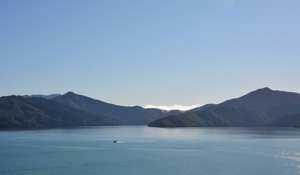
Photo Credit: Christopher Stephens, New Zealand Geographic Board
On 31 January 1770, Cook and several of his officers and crew ascended a hill on Motuara Island, carrying with them a post carved by the ship’s carpenter. There they erected the pole (with the apparent permission of a local koro called Topaa (Topea). Cook named ‘Queen Charlottes Sound’, after the King’s consort, and ‘claimed’ the sound and its adjacent lands for the Crown. They then drank a toast of wine to the Queen.
While the HMB Endeavour was in Queen Charlotte Sound, an anonymous officer noted down the local Māori name: Totarranooë.
Over the next several decades, warfare and migrations took place, shifting the relationships between hapū, iwi and the land. European whalers also arrived.
In 1839, the New Zealand Company, a private enterprise set up to colonise New Zealand, arrived and purchased land throughout the top of the South Island [Te Waipounamu] and at Wellington through three very dubious purchases (since discredited). The sound was referred to as ‘Totaranui’, the name referring to the many tōtara trees in the area.
In the 1920s and 1930s, the Honorary Geographic Board of New Zealand actively sought out ‘original’ Māori names for places. As part of this work, the Board considered ‘Totaranui’ as an alternative name for Queen Charlotte Sound. The Chief Surveyor reported that the name was on their maps and was used on the New Zealand Company’s deed of settlements. The name was adopted as an alternative to ‘Queen Charlotte Sound’.
In 2014, the dual name Queen Charlotte Sound / Tōtaranui was made official by three acts that addressed the claim settlements of Ngāti Kōata, Ngāti Rārua, Ngāti Tama ki Te Tau Ihu and Te Ātiawa o Te Waka-a-Māui, and Ngāti Apa ki te Rā Tō, Ngāti Kuia, and Rangitāne o Wairau, and Ngati Toa Rangatira.
References
- NZ Gazetteer -Queen Charlotte Sound / Tōtaranui
- James Cook, ‘31 January 1770’, South Seas: Voyaging and Cross-Cultural Encounters in the Pacific (1760-1800)
- Referenced in Trevor Cobeldick, Cook voyage place names of New Zealand, Paerangi Books, Wellington, 2001, p. 45
- NZGB, Correspondence, Vol 3, p. 125
- NZGB Minutes, 4 July 1930, p. 5